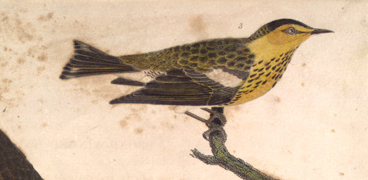Now here’s a true mega: A Cape May Warbler, the second for Britain, is being seen on Unst, that delightfully named island in the Shetlands.

Inevitably, the oldtimers have already started reminiscing about that much brighter, male Cape May that set up shop in Paisley, Scotland, in June 1977. And, inevitably, journalists and others have been trotting out the old canard:
Interestingly, the ornithologist who first discovered the species, Alexander Wilson, was born and spent his youth in Paisley….
But our warbler had been known to science for half a century by the time Wilson learned of its existence. In 1789, more than two decades before Wilson put pen to paper about what he mistakenly considered a “new and beautiful little species,” Gmelin knew the bird — and gave it the nicely descriptive name Motacilla tigrina in his edition of Linnaeus’s Systema.
The real eye-opener here is — or should be — all the earlier citations Gmelin is able to adduce. Edwards, Brisson, Buffon, Pennant, and Latham had all described this warbler in the mid- and late eighteenth century, a couple of their accounts even accompanied by paintings.


So much for the notion that Wilson — who died 200 years ago this year — was the “discoverer” of the species.
Indeed, not even Wilson himself, though laboring under the notion that the warbler was unknown when he first saw it, claimed the bird as his own discovery. In his American Ornithology, he puts it as clearly as anyone possibly could:
This new and beautiful little species was discovered in a maple swamp, in Cape May county, not far from the coast, by Mr. George Ord….
The latest book-length study of Wilson, Burtt and Davis’s Alexander Wilson, points this out — and identifies what has meanwhile become the authoritative source of the subsequent error, namely, Audubon’s account of the species in the Ornithological Biography:
Of this beautiful species, which was first described by Wilson, very little is known…. I am indebted for the fine specimens … to my generous friend Edward Harris….
Now there’s an irony. Audubon devoted so much energy to denying Wilson‘s priority in other cases, but here, thanks to his profound disdain for George Ord (or to sloppy reading and even sloppier bibliographic work), he created a myth that is still being retold nearly two hundred years later.
But we all know better. Three cheers for Edwards and the rest!



